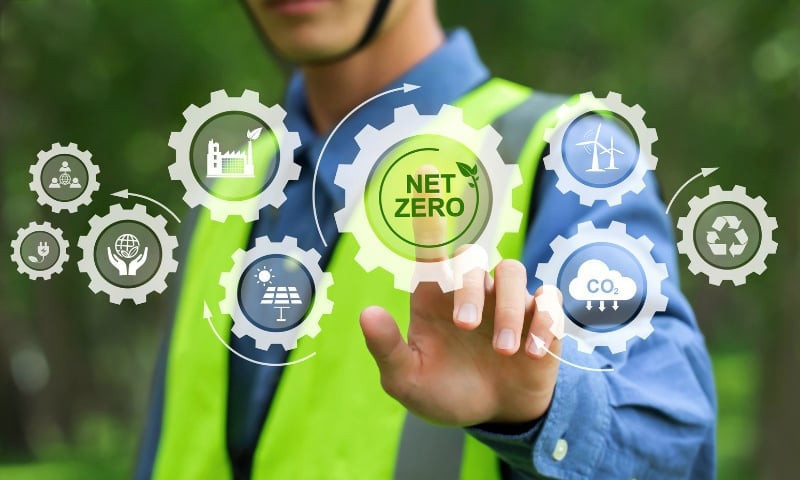If left unaddressed, emissions could surge to 927.9 million tons by 2030 - an increase of 3.26 times.
In response, the government has introduced a roadmap to achieve net-zero emissions by 2050 under the National Climate Change Strategy.
Dr. Nguyen Sy Linh, Head of the Climate Change Division at the Institute of Policy and Strategy for Agricultural and Rural Development, shared insights with Nhan Dan on Vietnam’s strategic direction and concrete policy solutions - highlighting the essential role of enterprises in realizing national climate goals.
Rising emissions: energy sector at the center of the challenge

According to Dr. Linh, climate response and GHG reduction remain relatively new areas in Vietnam. However, emissions reduction is not solely a technical matter - it is deeply intertwined with socioeconomic development.
National GHG inventories for 2000, 2010, 2013, 2014, and 2016 have been published, with updated figures expected soon.
The energy sector accounted for 65% of total emissions in 2016. This comes mainly from fossil fuel combustion for electricity generation and transportation.
If no policy or technical measures are taken, emissions in the energy sector could rise to 678.4 million tons CO₂ equivalent by 2030 - 73.1% of the total forecast.
This presents a major obstacle for Vietnam’s growth aspirations, as energy is vital to the nation’s path to becoming a developed country by 2045.
Strategic shift: roadmap to net-zero by 2050
The 2022 National Climate Change Strategy, formalized under Decision No. 896/QD-TTg, outlines Vietnam’s official commitment to achieving net-zero emissions. This follows Prime Minister Pham Minh Chinh’s pledge at COP26 in the UK.
Key targets include:
By 2030: A 43.5% reduction in GHG emissions compared to the Business-as-Usual (BAU) scenario. This includes: Energy sector: capped at 457 million tons (32.6% reduction); Agriculture: 64 million tons (43.0% reduction); Land use, land-use change, and forestry (LULUCF): -95 million tons (70% emission cut, 20% carbon absorption increase); Waste: 18 million tons (60.7% reduction); Industrial processes: 86 million tons (38.3% reduction)
By 2050: Net-zero emissions, with: Energy: reduced by 91.6% to 101 million tons; Agriculture: reduced by 63.1% to 56 million tons; LULUCF: -185 million tons (90% reduction and 30% carbon absorption increase); Waste: reduced by 90.7% to 8 million tons; Industry: reduced by 84.8% to 20 million tons; Facilities emitting more than 200 tons of CO₂ equivalent per year will be mandated to cut emissions.
Green transition in energy, agriculture, and forestry
Vietnam is integrating GHG reduction measures into everyday life. Pilot initiatives like low-emission rice cultivation on one million hectares and domestic carbon market development are underway. Communication campaigns, particularly targeting children and sustainable transport, are also expanding.
In energy, policies prioritize:
Renewable energy and efficient power use
Ending coal plant development after 2030, reducing capacity after 2035
Energy storage technologies and smart grids
Research into carbon capture and storage (CCS) and safe nuclear energy
The Just Energy Transition Partnership (JETP) offers global support for Vietnam's clean energy transition.
In agriculture, solutions include organic farming, crop structure transformation, and reuse of agricultural by-products. These help cut emissions while promoting a circular economy.
Forestry measures focus on:
Forest conservation and afforestation
Enrichment planting of degraded forests
Sustainable forest management and certification
Agroforestry expansion to increase carbon uptake and resist soil degradation
Enterprises: key drivers of low-carbon development
Vietnamese businesses increasingly face international requirements to report emissions or disclose carbon footprints. These may not yet be legally mandated within Vietnam but are vital for market access in regions with green standards.
Dr. Linh emphasized that businesses are both emission sources and solution providers. With capital, technology, and managerial capacity, they can:
Invest in cleaner production
Shift to green supply chains
Participate in carbon markets
Unlock funding from green finance instruments
Under Decision No. 13/2024/QD-TTg, 2,166 large-emission enterprises across five sectors are now obligated to conduct GHG inventories. These businesses will receive emission quotas for trading on domestic carbon markets.
Business action: not just a responsibility, but a competitive edge
Consumer demand is shifting toward low-carbon, eco-friendly products. Those that are certified and transparent about emissions command higher prices. Enterprises must embrace this green wave to remain competitive.
Vietnam’s green investment needs are enormous:
$59 billion in renewable energy
$80 billion in green buildings
$600 billion in sustainable transport
Green finance is closely tied to emissions performance, with instruments such as green bonds and international climate funds (GCF, GEF) providing opportunities.
Strategic recommendations for enterprises
To stay competitive and align with national targets, Dr. Linh recommends:
Voluntary GHG inventories: Even if not mandatory, this fosters transparency and builds trust.
Phased emissions reduction plans: Integrate emissions targets into corporate strategies and investment planning.
Green technology investments: Focus on long-term efficiency and market access.
Engage in carbon markets: Especially for sectors like renewables, agriculture, and manufacturing with carbon credit potential.
Capacity building: Train staff, update knowledge on regulations like CBAM (EU’s Carbon Border Adjustment Mechanism) and EUDR (anti-deforestation law).
“Climate action is no longer optional. It is the ethical standard and strategic imperative for sustainable development,” Dr. Linh concluded.
Nhan Dan